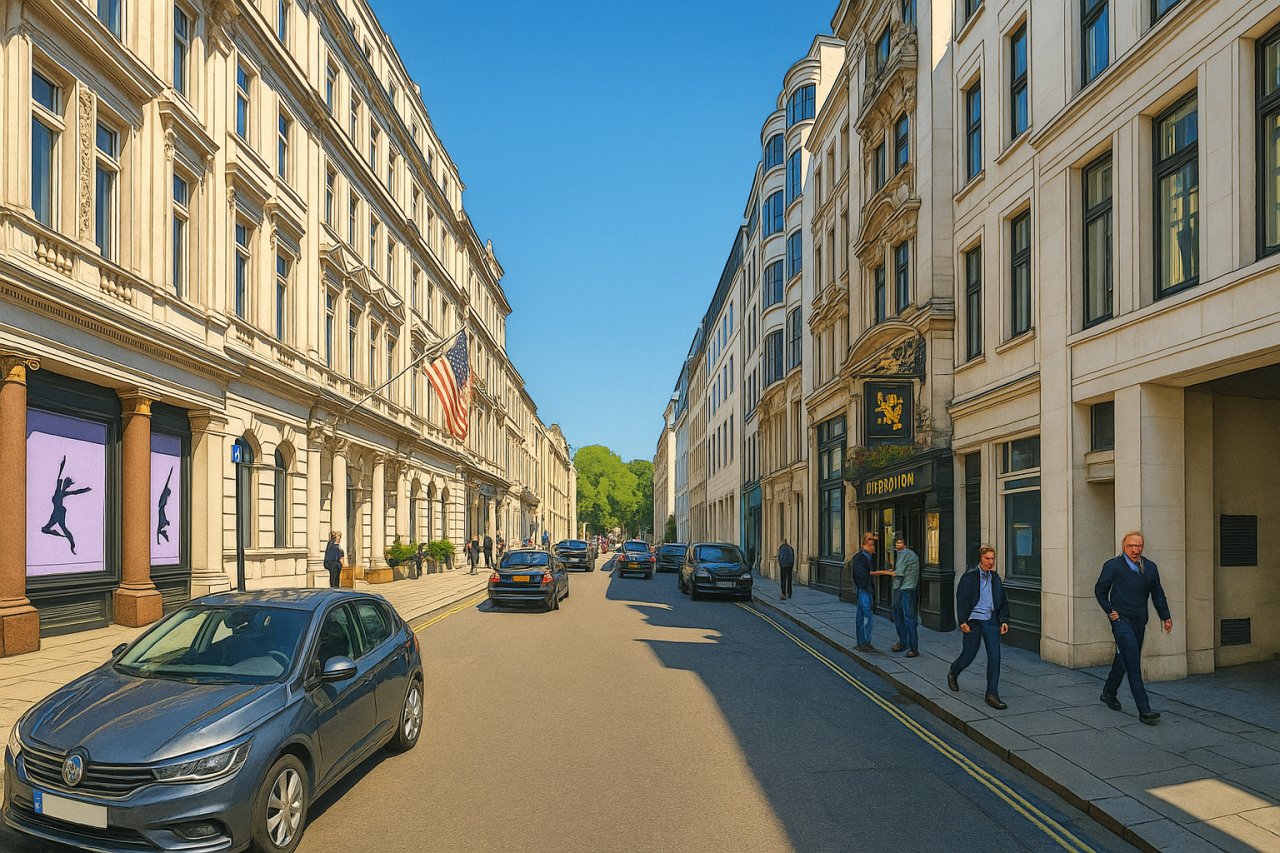
King Street, St James's, London
King Street in St James’s, London, is a distinguished and compact street steeped in Georgian elegance and historical significance. Not to be confused with other King Streets around the capital, this particular stretch lies entirely within the City of Westminster, extending westward from St James’s Square to St James’s Street.
Overview and Orientation
King Street is a short, one-way road running east to west for approximately 240 metres (about 787 feet). The road begins at the western side of St James’s Square and ends at St James’s Street, just a few paces north of St James’s Palace. Bury Street forms a T-junction to it on the north side. Vehicular traffic travels from east to west, exiting the square and joining the bustling thoroughfare of St James’s Street.
Historical Background
King Street was laid out in the late 17th century as part of the broader development of St James’s, an area that quickly became one of London's most fashionable districts following the restoration of the monarchy under King Charles II. It is likely that the street was named to honour the King, a practice common at the time as part of a general celebration of royal authority and patronage.
The street has retained its aristocratic air ever since, with elegant architecture and proximity to royal residences such as St James’s Palace giving it an enduring cachet. Over the centuries, it has hosted members of the aristocracy, private clubs, fine retailers, and even key institutions of the art world.
Character and Ambience
Today, King Street retains an air of quiet prestige. It is a relatively narrow and low-traffic street flanked by a blend of Georgian, Victorian, and early 20th-century buildings, many of which have been sympathetically restored. The character is more corporate and cultural than residential, with art galleries, auction houses, and private businesses occupying much of the street frontage.
Christie’s Auction House
The most famous landmark on King Street is Christie’s London, the flagship building of the world-renowned auction house, located at 8 King Street. Christie’s has occupied this location since 1823 and regularly hosts major sales of fine art, jewellery, antiques, and collectibles. Public viewings before auctions allow locals and visitors to experience masterpieces up close.
St James’s Square
At its eastern end, King Street opens onto St James’s Square, one of the oldest and most elegant garden squares in London. Surrounded by grand buildings, including private clubs and corporate headquarters, the square is a quiet refuge from the bustle of nearby Piccadilly.
Property and Real Estate
King Street is not primarily residential, but where residential units exist—typically above commercial premises—they command very high prices due to the central location and historical prestige. As of early 2025, properties on or immediately adjacent to King Street sell for an average of £2,300–£2,800 per sq ft (£24,750–£30,140 per sq m)1. This places it among the most expensive real estate markets in London, on par with other streets in St James’s and Mayfair. Residential units are typically compact—often between 1,000 and 1,500 sq ft (93 to 139 sq m)—but exquisitely finished and often listed.
Transport Links
Nearest Underground Stations
- Green Park Station (5-minute walk north-west): served by the Piccadilly, Victoria, and Jubilee lines.
- Piccadilly Circus Station (7-minute walk north-east): served by the Piccadilly and Bakerloo lines.
- Charing Cross Station (10-minute walk to the east): served by the Bakerloo and Northern lines, and National Rail services.
Nearby Bus Routes
Several bus stops are located along Pall Mall, Piccadilly, and Regent Street, all within walking distance of King Street. Common routes include:
- Bus 9 (Aldwych to Hammersmith)
- Bus 14 (Putney Heath to Russell Square)
- Bus 19 (Finsbury Park to Battersea Bridge)
Fun Fact
Christie’s, based at 8 King Street, has auctioned some of the most expensive artworks in history from this location—including Old Masters, post-war masterpieces, and royal artefacts. Walking past its glass front, you may find yourself mere feet from a Monet, a Banksy, or even a Fabergé egg.
Quick Facts
- Location: St James’s, City of Westminster, London
- Length: Approx. 240 metres (787 feet)
- Traffic direction: One-way east to west
- Historical era: Laid out in the late 17th century
- Named for: King Charles II, reflecting royal patronage
- Key landmarks: Christie’s Auction House, St James’s Square
- Character: Prestigious, cultural, commercial
- Property prices: £2,300–£2,800 per sq ft (as of 2025)
- Nearest Underground: Green Park, Piccadilly Circus, Charing Cross
- Nearby bus routes: 9, 14, 19, among others
- Fun fact: Christie’s on King Street has auctioned world-famous masterpieces
References
Map of King Street, London

Painting of King Street, London (View image in full size)